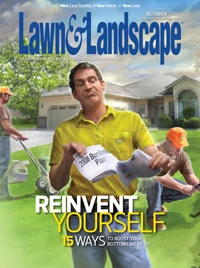It’s downright frightening to be self-employed when you think of the world today: a sluggish economy, rising gas prices and less expendable income. But there’s a secret to staying in business and surviving economic downturns. Developing customer loyalty will help you keep your customers, even if you’re not the cheapest in town. Lawn and landscape professionals might need to re-invent themselves to be more customer-centric. Every thing you do revolves around them. Customer centricity is not just an idea or concept; it is a business principle that drives action.
Prior to taking the leap into self-employment, I spent more than 30 years in retail management with big box names such as Wal-Mart, Best Buy and Lowe’s. Wal-Mart founder Sam Walton realized long ago that the key to business longevity was how well he treated his customers. In our company, customer service isn’t a cliché. It’s our way of life.
If the only communication your customer receives from you is a monthly invoice for mowing, you’re making a big mistake. I’ve done landscaping projects where customers are flabbergasted at the level of communication. They know when I’ll be there, what I’ll be doing, how long I’ll be doing it and what they can expect. If our crew is running late, they get a call or an e-mail from my Blackberry. Keeping them informed makes them feel like they’re No. 1. They feel as if they’re part of the project and not just part of the checkbook. It’s that engagement that builds loyalty.
We ask if there are certain times of the day they don’t want the lawn mowed or land care to be done. We ask if they want organic or synthetic. These guidelines will create fewer customer disappointments. Setting clear expectations gives you and the customer peace of mind. A level playing field where both parties have an equal understanding of what’s happening and what will happen sets the stage for building the relationship needed to satisfy your customer’s needs and maintain their business.
Remember that we’re the experts. Customers might not come right out and ask us about a drainage problem they have, or about land erosion issues or even a landscaping project they are considering. They expect us to see those issues and offer solutions. Even if the customer decides not to go with your suggestions, you’ve planted the seed for future business and shown the potential customer that you’ve got their best interest in mind.
In retail, the little things always seemed to make a difference with the customer. Thanking them as they leave. Clean restrooms. Polite cashiers. Landscaping and lawn care are no different. This summer I installed a small mowing strip for a family. It was a two-day project and on my way to the site the second day, I stopped for coffee. I called the customer and asked if she’d like something. Silence. She was floored that a landscaper thought of her while buying coffee and offered to buy her a cup.
How many customers are lost because we fail to do the little things that help build relationships and customer loyalty?
Survival for small businesses in today’s economy can be challenging. It might involve reinventing yourself. Companies that embrace the vision of delivering a customer service product so good that customers will pay more for it will build customer loyalty and survive any economic environment. The quality of work isn’t enough anymore. Customers are more knowledgeable, possess a plethora of resources and will pull the plug on a business that doesn’t put them in the center. They need to feel important. They want inclusion.
When you put the customer in the center of your entire decision making process and are communicating with and engaging them, building a relationship, doing the little things that the customer might not even notice, then you have customer centricity. It goes well beyond your every day customer service. Practice it, teach it and embrace it, and you’ll be on your way to establishing long-term customer loyalty.
Want to be featured next month? E-mail the editor at mhepp@gie.net.
Get curated news on YOUR industry.
Enter your email to receive our newsletters.
Explore the October 2008 Issue
Check out more from this issue and find your next story to read.
Latest from Lawn & Landscape
- Landscape Workshop acquires EdgeForm Landscape Management
- Caterpillar's Umpleby transitions to executive chairman
- Sgro named Yanmar Compact Equipment's North American president
- APHIX acquires Curb Appeal Landscaping in Birmingham
- Project EverGreen helps revitalize Milan Park in Detroit
- Trex Company wins Product of the Year, Judges’ Choice Winner at Environment+Energy Leader Awards
- General Equipment & Supplies in Fargo adds Takeuchi equipment
- Mariani Premier Group acquires Hazeltine Nurseries






